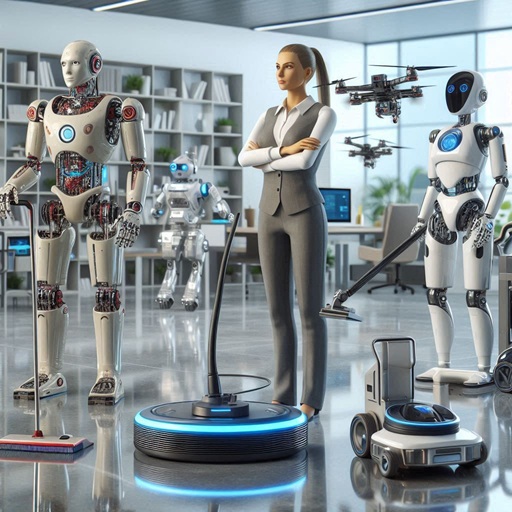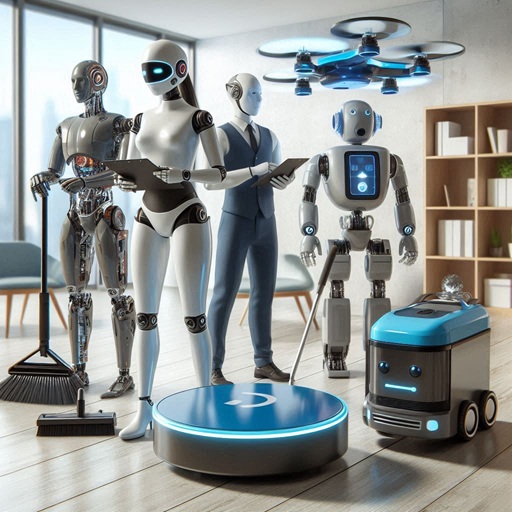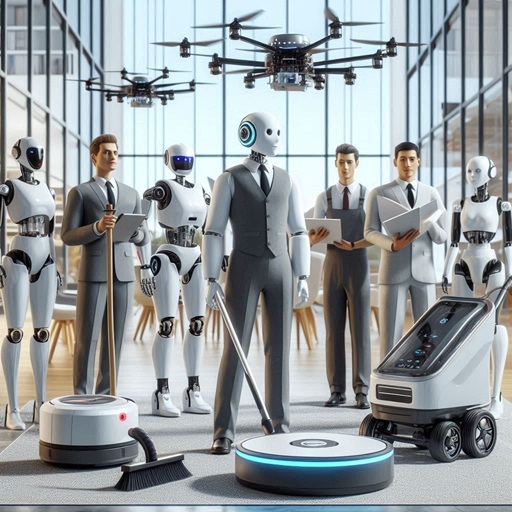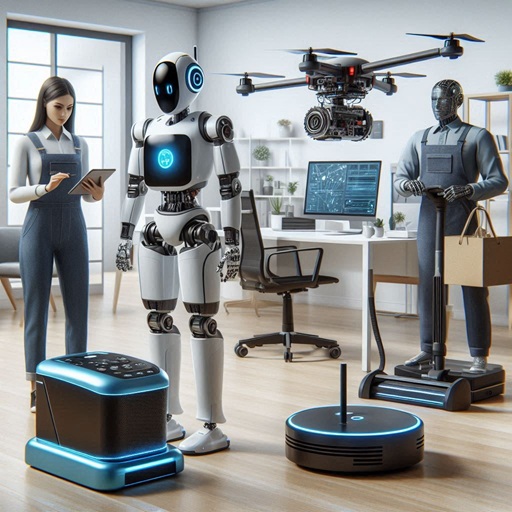The Professional Service Robots Market is experiencing unprecedented growth, driven by advancements in robotics, artificial intelligence (AI), and automation technologies. These robots are revolutionizing industries by performing tasks that are dangerous, repetitive, or require high precision. From healthcare to logistics, professional service robots are becoming indispensable tools for businesses worldwide. This article delves into the current trends, growth drivers, challenges, and future opportunities in the Professional Service Robots Market.
The service robotics market is projected to grow from USD 47.10 billion in 2024 to reach USD 98.65 billion by 2029; it is expected to grow at a CAGR of 15.9% from 2024 to 2029.
Professional service robots are autonomous or semi-autonomous machines designed to perform specific tasks in professional settings. Unlike industrial robots, which are primarily used in manufacturing, professional service robots are deployed in various sectors, including healthcare, agriculture, logistics, hospitality, and retail. These robots are equipped with advanced sensors, AI, and machine learning capabilities, enabling them to perform complex tasks with minimal human intervention.
Download PDF Brochure @ https://www.marketsandmarkets.com/pdfdownloadNew.asp?id=681
Key Market Trends
a. Integration of AI and Machine Learning
The integration of AI and machine learning technologies is a significant trend in the Professional Service Robots Market. These technologies enable robots to learn from their environment, adapt to new situations, and perform tasks with greater accuracy. For example, AI-powered robots in healthcare can assist surgeons during complex procedures, while machine learning algorithms help agricultural robots optimize crop yields.
b. Rise of Collaborative Robots (Cobots)
Collaborative robots, or cobots, are designed to work alongside humans in shared workspaces. These robots are gaining popularity in industries such as manufacturing, logistics, and healthcare due to their ability to enhance productivity and safety. Cobots are equipped with advanced sensors and safety features, allowing them to operate safely in close proximity to humans.
c. Increasing Adoption in Emerging Markets
Emerging markets, particularly in Asia-Pacific and Latin America, are witnessing a surge in the adoption of professional service robots. Rapid urbanization, industrialization, and government initiatives to promote automation are driving market growth in these regions. For instance, countries like China and India are investing heavily in robotics to address labor shortages and improve operational efficiency.
d. Focus on Sustainability
Sustainability is becoming a key focus area for manufacturers of professional service robots. Companies are developing energy-efficient robots that consume less power and produce minimal waste. Additionally, robots are being used to support sustainable practices, such as precision agriculture and waste management.
Growth Drivers of the Professional Service Robots Market
a. Rising Labor Costs
The increasing cost of labor is a major driver of the Professional Service Robots Market. Businesses are turning to robots to reduce dependency on human workers and cut operational costs. For example, in the hospitality industry, robots are being used for tasks such as cleaning, room service, and customer interaction.
b. Advancements in Robotics Technology
Technological advancements in robotics, including improved sensors, actuators, and control systems, are driving market growth. These advancements have made robots more affordable, reliable, and capable of performing a wide range of tasks.
c. Growing Demand for Automation
The demand for automation is growing across industries, driven by the need for efficiency, precision, and consistency. Professional service robots are being deployed in sectors such as healthcare, logistics, and agriculture to automate repetitive and time-consuming tasks.
d. Government Support and Funding
Governments worldwide are supporting the adoption of robotics through funding, grants, and favorable policies. For instance, the European Union’s Horizon 2020 program has allocated significant funds for robotics research and development.
Challenges and Restraints
a. High Initial Costs
The high initial cost of professional service robots is a major barrier to adoption, particularly for small and medium-sized enterprises (SMEs). While the long-term benefits of automation are significant, the upfront investment can be prohibitive for some businesses.
b. Lack of Skilled Workforce
The lack of a skilled workforce capable of operating and maintaining professional service robots is another challenge. Businesses need to invest in training programs to ensure their employees can effectively work with these advanced machines.
c. Regulatory and Ethical Concerns
Regulatory and ethical concerns surrounding the use of robots, particularly in healthcare and customer service, are also restraining market growth. Issues such as data privacy, job displacement, and safety need to be addressed to ensure widespread adoption.
Applications of Professional Service Robots
a. Healthcare
In the healthcare sector, professional service robots are used for tasks such as surgery assistance, patient care, and rehabilitation. Robots like the da Vinci Surgical System enable surgeons to perform minimally invasive procedures with greater precision.
b. Agriculture
Agricultural robots, or agribots, are used for tasks such as planting, harvesting, and crop monitoring. These robots help farmers optimize crop yields, reduce labor costs, and minimize environmental impact.
c. Logistics and Warehousing
In logistics and warehousing, robots are used for tasks such as sorting, packing, and transporting goods. Autonomous mobile robots (AMRs) and drones are increasingly being deployed to streamline operations and improve efficiency.
d. Hospitality
In the hospitality industry, robots are used for tasks such as cleaning, room service, and customer interaction. For example, robots like SoftBank’s Pepper are being used in hotels to greet guests and provide information.
Regional Analysis
a. North America
North America dominates the Professional Service Robots Market, driven by the presence of leading robotics companies and high adoption rates in healthcare and logistics. The United States is the largest market in the region, with significant investments in robotics research and development.
b. Europe
Europe is another key market for professional service robots, supported by government initiatives and funding programs. Countries like Germany, the UK, and France are leading the way in robotics adoption, particularly in manufacturing and healthcare.
c. Asia-Pacific
The Asia-Pacific region is expected to witness the highest growth during the forecast period, driven by rapid industrialization and urbanization. China, Japan, and South Korea are the largest markets in the region, with significant investments in robotics and automation.
d. Latin America and Middle East & Africa
These regions are also witnessing growing adoption of professional service robots, particularly in agriculture and logistics. Government initiatives to promote automation and address labor shortages are driving market growth.
Future Opportunities in the Market
a. Expansion into New Industries
The Professional Service Robots Market has significant growth potential in emerging industries such as construction, retail, and education. For example, robots are being used in construction for tasks such as bricklaying and site inspection.
b. Development of Customized Solutions
There is a growing demand for customized robotics solutions tailored to specific industry needs. Companies that can offer flexible and scalable solutions will have a competitive advantage in the market.
c. Focus on Human-Robot Collaboration
The future of professional service robots lies in enhancing human-robot collaboration. Advances in AI and machine learning will enable robots to work more effectively alongside humans, improving productivity and safety.
The Professional Service Robots Market is poised for significant growth in the coming years, driven by technological advancements, increasing demand for automation, and government support. While challenges such as high costs and regulatory concerns remain, the potential benefits of professional service robots are undeniable. As industries continue to embrace robotics, the market will witness new opportunities and innovations, transforming the way we work and live.
FAQs
Q1: What are professional service robots?
A1: Professional service robots are autonomous or semi-autonomous machines designed to perform specific tasks in professional settings, such as healthcare, agriculture, logistics, and hospitality.
Q2: What is driving the growth of the Professional Service Robots Market?
A2: The growth of the market is driven by rising labor costs, advancements in robotics technology, growing demand for automation, and government support.
Q3: What are the challenges in the Professional Service Robots Market?
A3: Challenges include high initial costs, lack of skilled workforce, and regulatory and ethical concerns.
Q4: Which industries are adopting professional service robots?
A4: Industries such as healthcare, agriculture, logistics, hospitality, and retail are adopting professional service robots.
Q5: What is the future of the Professional Service Robots Market?
A5: The future of the market lies in expansion into new industries, development of customized solutions, and enhanced human-robot collaboration.




